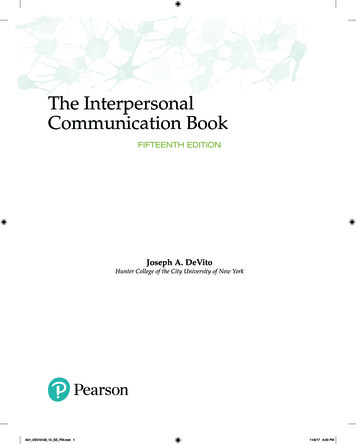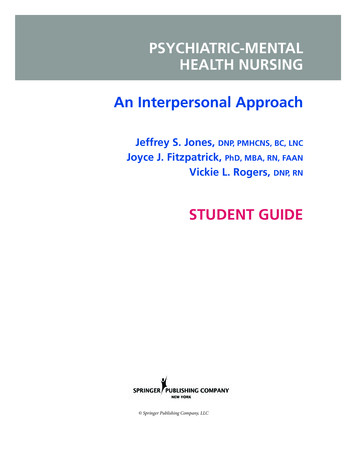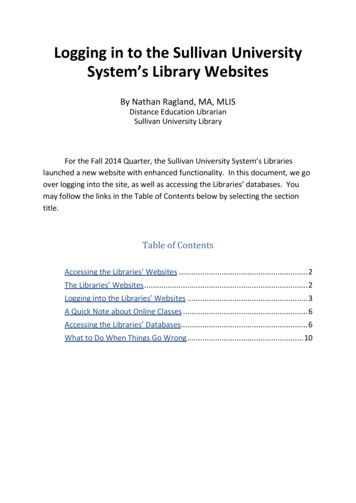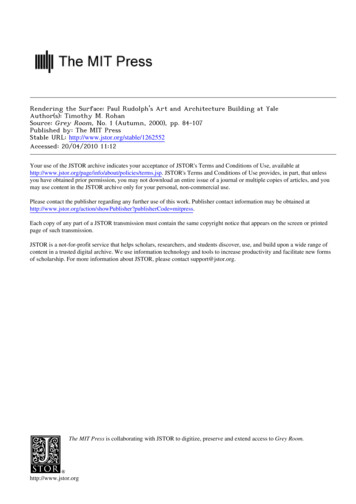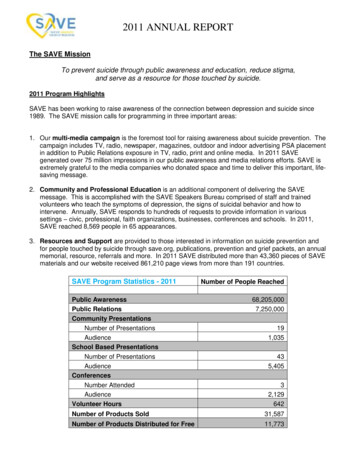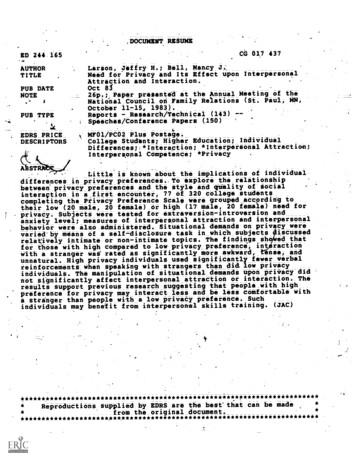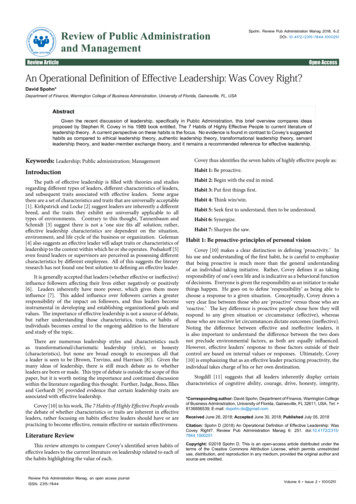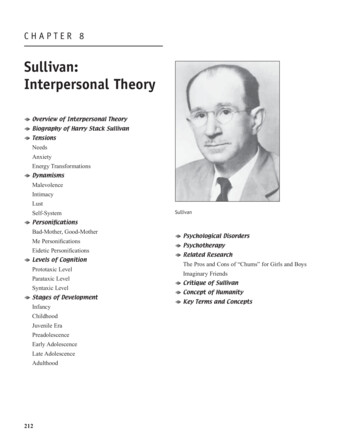
Transcription
CHAPTER 8Sullivan:Interpersonal TheoryB Overview of Interpersonal TheoryB Biography of Harry Stack SullivanB TensionsNeedsAnxietyEnergy TransformationsB nB PersonificationsBad-Mother, Good-MotherMe PersonificationsEidetic PersonificationsB Levels of CognitionPrototaxic LevelParataxic LevelSyntaxic LevelB Stages of DevelopmentInfancyChildhoodJuvenile EraPreadolescenceEarly AdolescenceLate AdolescenceAdulthood212B Psychological DisordersB PsychotherapyB Related ResearchThe Pros and Cons of “Chums” for Girls and BoysImaginary FriendsB Critique of SullivanB Concept of HumanityB Key Terms and Concepts
Chapter 8Sullivan: Interpersonal Theoryhe young boy had no friends his age but did have several imaginary playmates.At school, his Irish brogue and quick mind made him unpopular among schoolmates. Then, at age 81/2, the boy experienced an intimate relationship with a13-year-old boy that transformed his life. The two boys remained unpopular withother children, but they developed close bonds with each other. Most scholars(Alexander, 1990, 1995; Chapman, 1976; Havens, 1987) believe that the relationshipbetween these boys—Harry Stack Sullivan and Clarence Bellinger—was at least insome ways homosexual, but others (Perry, 1982) believed that the two boys werenever sexually intimate.Why is it important to know about Sullivan’s sexual orientation? This knowledge is important for at least two reasons. First, a personality theorist’s early life history, including gender, birth order, religious beliefs, ethnic background, schooling,as well as sexual orientation, all relate to that person’s adult beliefs, conception ofhumanity, and the type of personality theory that that person will develop.Second, in Sullivan’s case, his sexual orientation may have prevented him fromgaining the acceptance and recognition he might have had if others had not suspectedthat he was homosexual. A. H. Chapman (1976) has argued that Sullivan’s influenceis pervasive yet unrecognized largely because many psychologists and psychiatristsof his day had difficulty accepting the theoretical concepts and therapeutic practicesof someone they suspected of being homosexual. Chapman contended that Sullivan’scontemporaries might have easily accepted a homosexual artist, musician, or writer,but, when it came to a psychiatrist, they were still guided by the concept “Physicianheal thyself.” This phrase was so ingrained in American society during Sullivan’stime that mental health workers found it very difficult to “admit their indebtednessto a psychiatrist whose homosexuality was commonly known” (Chapman, 1976, p.12). Thus, Sullivan, who otherwise might have achieved greater fame, was shackledby sexual prejudices that kept him from being regarded as American’s foremost psychiatrist of the first half of the 20th century.TOverview of Interpersonal TheoryHarry Stack Sullivan, the first American to construct a comprehensive personalitytheory, believed that people develop their personality within a social context. Without other people, Sullivan contended, humans would have no personality. “A personality can never be isolated from the complex of interpersonal relations in whichthe person lives and has his being” (Sullivan, 1953a, p. 10). Sullivan insisted thatknowledge of human personality can be gained only through the scientific study ofinterpersonal relations. His interpersonal theory emphasizes the importance of various developmental stages—infancy, childhood, the juvenile era, preadolescence,early adolescence, late adolescence, and adulthood. Healthy human developmentrests on a person’s ability to establish intimacy with another person, but unfortunately, anxiety can interfere with satisfying interpersonal relations at any age. Perhaps the most crucial stage of development is preadolescence—a period when children first possess the capacity for intimacy but have not yet reached an age at whichtheir intimate relationships are complicated by lustful interests. Sullivan believedthat people achieve healthy development when they are able to experience both intimacy and lust toward the same other person.213
214Part IIPsychodynamic TheoriesIronically, Sullivan’s own relationships with other people were seldom satisfying. As a child, he was lonely and physically isolated; as an adolescent, he sufferedat least one schizophrenic episode; and as an adult, he experienced only superficialand ambivalent interpersonal relationships. Despite, or perhaps because of, these interpersonal difficulties, Sullivan contributed much to an understanding of humanpersonality. In Leston Havens’s (1987) language, “He made his contributions walking on one leg . . . he never gained the spontaneity, receptiveness, and capacity forintimacy his own interpersonal school worked to achieve for others” (p. 184).Biography of Harry Stack SullivanHarry Stack Sullivan was born in the small farming town of Norwich, New York, onFebruary 21, 1892, the sole surviving child of poor Irish Catholic parents. Hismother, Ella Stack Sullivan, was 32 when she married Timothy Sullivan and 39 whenHarry was born. She had given birth to two other sons, neither of whom lived pastthe first year. As a consequence, she pampered and protected her only child, whosesurvival she knew was her last chance for motherhood. Harry’s father, Timothy Sullivan, was a shy, withdrawn, and taciturn man who never developed a close relationship with his son until after his wife had died and Sullivan had become a prominentphysician. Timothy Sullivan had been a farm laborer and a factory worker whomoved to his wife’s family farm outside the village of Smyrna, some 10 miles fromNorwich, before Harry’s third birthday. At about this same time, Ella Stack Sullivanwas mysteriously absent from the home, and Sullivan was cared for by his maternalgrandmother, whose Gaelic accent was not easily understood by the young boy. Aftermore than a year’s separation, Harry’s mother—who likely had been in a mental hospital—returned home. In effect, Sullivan then had two women to mother him. Evenafter his grandmother died, he continued to have two mothers because a maiden auntthen came to share in the child-rearing duties.Although both parents were of poor Irish Catholic descent, his mother regarded the Stack family as socially superior to the Sullivans. Sullivan accepted thesocial supremacy of the Stacks over the Sullivans until he was a prominent psychiatrist developing an interpersonal theory that emphasized similarities among peoplerather than differences. He then realized the folly of his mother’s claims.As a preschool child, Sullivan had neither friends nor acquaintances of his age.After beginning school he still felt like an outsider, being an Irish Catholic boy in aProtestant community. His Irish accent and quick mind made him unpopular with hisclassmates throughout his years of schooling in Smyrna.When Sullivan was 81/2 years old, he formed a close friendship with a 13-yearold boy from a neighboring farm. This chum was Clarence Bellinger, who lived amile beyond Harry in another school district, but who was now beginning highschool in Smyrna. Although the two boys were not peers chronologically, they hadmuch in common socially and intellectually. Both were retarded socially but advanced intellectually; both later became psychiatrists and neither ever married. Therelationship between Harry and Clarence had a transforming effect on Sullivan’s life.It awakened in him the power of intimacy, that is, the ability to love another who wasmore or less like himself. In Sullivan’s mature theory of personality, he placed heavyemphasis on the therapeutic, almost magical power of an intimate relationship dur-
Chapter 8Sullivan: Interpersonal Theorying the preadolescent years. This belief, along with many other Sullivanian hypotheses, seems to have grown out of his own childhood experiences.Sullivan was interested in books and science, not in farming. Although he wasan only child growing up on a farm that required much hard work, Harry was ableto escape many of the chores by absentmindedly “forgetting” to do them. This rusewas successful because his indulgent mother completed them for him and allowedSullivan to receive credit.A bright student, Sullivan graduated from high school as valedictorian at age16. He then entered Cornell University intending to become a physicist, although healso had an interest in psychiatry. His academic performance at Cornell was a disaster, however, and he was suspended after 1 year. The suspension may not have beensolely for academic deficiencies. He got into trouble with the law at Cornell, possibly for mail fraud. He was probably a dupe of older, more mature students who usedhim to pick up some chemicals illegally ordered through the mail. In any event, forthe next 2 years Sullivan mysteriously disappeared from the scene. Perry (1982) reported he may have suffered a schizophrenic breakdown at this time and was confined to a mental hospital. Alexander (1990), however, surmised that Sullivan spentthis time under the guidance of an older male model who helped him overcome hissexual panic and who intensified his interest in psychiatry. Whatever the answer toSullivan’s mysterious disappearance from 1909 to 1911, his experiences seemed tohave matured him academically and possibly sexually.In 1911, with only one very unsuccessful year of undergraduate work, Sullivan enrolled in the Chicago College of Medicine and Surgery, where his grades,though only mediocre, were a great improvement over those he earned at Cornell. Hefinished his medical studies in 1915 but did not receive his degree until 1917. Sullivan claimed that the delay was because he had not yet paid his tuition in full, butPerry (1982) found evidence that he had not completed all his academic requirements by 1915 and needed, among other requirements, an internship. How was Sullivan able to obtain a medical degree if he lacked all the requirements? None of Sullivan’s biographers has a satisfactory answer to this question. Alexander (1990)hypothesized that Sullivan, who had accumulated nearly a year of medically relatedemployment, used his considerable persuasive abilities to convince authorities atChicago College of Medicine and Surgery to accept that experience in lieu of an internship. Any other deficiency may have been waived if Sullivan agreed to enlist inthe military. (The United States had recently entered World War I and was in need ofmedical officers.)After the war Sullivan continued to serve as a military officer, first for the Federal Board for Vocational Education and then for the Public Health Service. However, this period in his life was still confusing and unstable, and he showed littlepromise of the brilliant career that lay just ahead (Perry, 1982).In 1921, with no formal training in psychiatry, he went to St. ElizabethHospital in Washington, DC, where he became closely acquainted with WilliamAlanson White, one of America’s best-known neuropsychiatrists. At St. Elizabeth,Sullivan had his first opportunity to work with large numbers of schizophrenic patients. While in Washington, he began an association with the Medical School of theUniversity of Maryland and with the Sheppard and Enoch Pratt Hospital in Towson,Maryland. During this Baltimore period of his life, he conducted intensive studies of215
216Part IIPsychodynamic Theoriesschizophrenia, which led to his first hunches about the importance of interpersonalrelationships. In trying to make sense out of the speech of schizophrenic patients,Sullivan concluded that their illness was a means of coping with the anxiety generated from social and interpersonal environments. His experiences as a practicing clinician gradually transformed themselves into the beginnings of an interpersonal theory of psychiatry.Sullivan spent much of his time and energy at Sheppard selecting and traininghospital attendants. Although he did little therapy himself, he developed a system inwhich nonprofessional but sympathetic male attendants treated schizophrenic patients with human respect and care. This innovative program gained him a reputationas a clinical wizard. However, he became disenchanted with the political climate atSheppard when he was passed over for a position as head of the new reception center that he had advocated. In March of 1930, he resigned from Sheppard.Later that year, he moved to New York City and opened a private practice, hoping to enlarge his understanding of interpersonal relations by investigating nonschizophrenic disorders, especially those of an obsessive nature (Perry, 1982). Timeswere hard, however, and his expected wealthy clientele did not come in the numbershe needed to maintain his expenses.On a more positive note, his residence in New York brought him into contactwith several psychiatrists and social scientists with a European background. Amongthese were Karen Horney, Erich Fromm, and Frieda Fromm-Reichmann who, alongwith Sullivan, Clara Thompson, and others, formed the Zodiac group, an informalorganization that met regularly over drinks to discuss old and new ideas in psychiatry and the related social sciences. Sullivan, who had met Thompson earlier, persuaded her to travel to Europe to take a training analysis under Sandor Ferenczi, adisciple of Freud. Sullivan learned from all members of the Zodiac group, andthrough Thompson, and Ferenczi, his therapeutic technique was indirectly influencedby Freud. Sullivan also credited two other outstanding practitioners, Adolf Meyerand William Alanson White, as having had an impact on his practice of therapy. Despite some Freudian influence on his therapeutic technique, Sullivan’s theory of interpersonal psychiatry is neither psychoanalytic nor neo-Freudian.During his residence in New York, Sullivan also came under the influence ofseveral noted social scientists from the University of Chicago, which was the centerof American sociological study during the 1920s and 1930s. Included among themwere social psychologist George Herbert Mead, sociologists Robert Ezra Park andW. I. Thomas, anthropologist Edward Sapir, and political scientist Harold Lasswell.Sullivan, Sapir, and Lasswell were primarily responsible for establishing the WilliamAlanson White Psychiatric Foundation in Washington, DC, for the purpose of joining psychiatry to the other social sciences. Sullivan served as the first president ofthe foundation and also as editor of the foundation’s journal, Psychiatry. Under Sullivan’s guidance, the foundation began a training institution known as the Washington School of Psychiatry. Because of these activities, Sullivan gave up his New Yorkpractice, which was not very lucrative anyway, and moved back to Washington, DC,where he remained closely associated with the school and the journal.In January 1949, Sullivan attended a meeting of the World Federation for Mental Health in Amsterdam. While on his way home, January 14, 1949, he died of acerebral hemorrhage in a Paris hotel room, a few weeks short of his 57th birthday.Not uncharacteristically, he was alone at the time.
Chapter 8Sullivan: Interpersonal TheoryOn the personal side, Sullivan was not comfortable with his sexuality and hadambivalent feelings toward marriage (Perry, 1982). As an adult, he brought into hishome a 15-year-old boy who was probably a former patient (Alexander, 1990). Thisyoung man—James Inscoe—remained with Sullivan for 22 years, looking after hisfinancial affairs, typing manuscripts, and generally running the household. AlthoughSullivan never officially adopted Jimmie, he regarded him as a son and even had hislegal name changed to James I. Sullivan.Beyond Biography Was Sullivan a homosexual? ForWWWinformation on Sullivan’s sexual orientation, see our website atwww.mhhe.com/feist7Sullivan also had ambivalent attitudes toward his religion. Born to Catholicparents who attended church only irregularly, he abandoned Catholicism early on. Inlater life, his friends and acquaintances regarded him as nonreligious or even antiCatholic, but to their surprise, Sullivan had written into his will a request to receivea Catholic burial. Incidentally, this request was granted despite the fact that Sullivan’s body had been cremated in Paris. His ashes were returned to the United States,where they were placed inside a coffin and received a full Catholic burial, completewith a requiem mass.Sullivan’s chief contribution to personality theory is his conception of developmental stages. Before turning to Sullivan’s ideas on the stages of development, wewill explain some of his unique terminology.TensionsLike Freud and Jung, Sullivan (1953b) saw personality as an energy system. Energycan exist either as tension (potentiality for action) or as actions themselves (energytransformations). Energy transformations transform tensions into either covert orovert behaviors and are aimed at satisfying needs and reducing anxiety. Tension is apotentiality for action that may or may not be experienced in awareness. Thus, notall tensions are consciously felt. Many tensions, such as anxiety, premonitions,drowsiness, hunger, and sexual excitement, are felt but not always on a consciouslevel. In fact, probably all felt tensions are at least partial distortions of reality.Sullivan recognized two types of tensions: needs and anxiety. Needs usually result in productive actions, whereas anxiety leads to nonproductive or disintegrativebehaviors.NeedsNeeds are tensions brought on by biological imbalance between a person and thephysiochemical environment, both inside and outside the organism. Needs areepisodic—once they are satisfied, they temporarily lose their power, but after a time,they are likely to recur. Although needs originally have a biological component,many of them stem from the interpersonal situation. The most basic interpersonalneed is tenderness. An infant develops a need to receive tenderness from its primarycaretaker (called by Sullivan “the mothering one”). Unlike some needs, tendernessrequires actions from at least two people. For example, an infant’s need to receive217
218Part IIPsychodynamic Theoriestenderness may be expressed as a cry, smile, or coo, whereas the mother’s need togive tenderness may be transformed into touching, fondling, or holding. In this example, the need for tenderness is satisfied through the use of the infant’s mouth andthe mother’s hands.Tenderness is a general need because it is concerned with the overall wellbeing of a person. General needs, which also include oxygen, food, and water, areopposed to zonal needs, which arise from a particular area of the body. Several areasof the body are instrumental in satisfying both general and zonal needs. For example, the mouth satisfies general needs by taking in food and oxygen, but it also satisfies the zonal need for oral activity. Also, the hands may be used to help satisfy thegeneral need of tenderness, but they can likewise be used to satisfy the zonal needfor manual activity. Similarly, other body zones, such as the anus and the genitals,can be used to satisfy both kinds of needs.Very early in life, the various zones of the body begin to play a significant andlasting role in interpersonal relations. While satisfying general needs for food, water,and so forth, an infant expends more energy than necessary, and the excess energyis transformed into consistent characteristic modes of behavior, which Sullivancalled dynamisms.AnxietyA second type of tension, anxiety, differs from tensions of needs in that it is disjunctive, is more diffuse and vague, and calls forth no consistent actions for its relief. If infants lack food (a need), their course of action is clear; but if they are anxious, they can do little to escape from that anxiety.How does anxiety originate? Sullivan (1953b) postulated that it is transferredfrom the parent to the infant through the process of empathy. Anxiety in the mothering one inevitably induces anxiety in the infant. Because all mothers have someamount of anxiety while caring for their babies, all infants will become anxious tosome degree.Just as the infant does not have the capacity to reduce anxiety, the parent hasno effective means of dealing with the baby’s anxiety. Any signs of anxiety or insecurity by the infant are likely to lead to attempts by the parent to satisfy the infant’sneeds. For example, a mother may feed her anxious, crying baby because she mistakes anxiety for hunger. If the baby hesitates in accepting the milk, the mother maybecome more anxious herself, which generates additional anxiety within the infant.Finally, the baby’s anxiety reaches a level at which it interferes with sucking andswallowing. Anxiety, then, operates in opposition to tensions of needs and preventsthem from being satisfied.Anxiety has a deleterious effect on adults too. It is the chief disruptive forceblocking the development of healthy interpersonal relations. Sullivan (1953b)likened severe anxiety to a blow on the head. It makes people incapable of learning,impairs memory, narrows perception, and may result in complete amnesia. It isunique among the tensions in that it maintains the status quo even to people’s overall detriment. Whereas other tensions result in actions directed specifically towardtheir relief, anxiety produces behaviors that (1) prevent people from learning fromtheir mistakes, (2) keep people pursuing a childish wish for security, and (3) generally ensure that people will not learn from their experiences.
Chapter 8Sullivan: Interpersonal TheorySullivan insisted that anxiety and loneliness are unique among all experiencesin that they are totally unwanted and undesirable. Because anxiety is painful, peoplehave a natural tendency to avoid it, inherently preferring the state of euphoria, orcomplete lack of tension. Sullivan (1954) summarized this concept by stating simplythat “the presence of anxiety is much worse than its absence” (p. 100).Sullivan distinguished anxiety from fear in several important ways. First, anxiety usually stems from complex interpersonal situations and is only vaguely represented in awareness; fear is more clearly discerned and its origins more easily pinpointed. Second, anxiety has no positive value. Only when transformed into anothertension (anger or fear, for example) can it lead to profitable actions. Third, anxietyblocks the satisfaction of needs, whereas fear sometimes helps people satisfy certainneeds. This opposition to the satisfaction of needs is expressed in words that can beconsidered Sullivan’s definition of anxiety: “Anxiety is a tension in opposition to thetensions of needs and to action appropriate to their relief ” (Sullivan, 1953b, p. 44).Energy TransformationsTensions that are transformed into actions, either overt or covert, are called energytransformations. This somewhat awkward term simply refers to our behaviors thatare aimed at satisfying needs and reducing anxiety—the two great tensions. Not allenergy transformations are obvious, overt actions; many take the form of emotions,thoughts, or covert behaviors that can be hidden from other people.DynamismsEnergy transformations become organized as typical behavior patterns that characterize a person throughout a lifetime. Sullivan (1953b) called these behavior patternsdynamisms, a term that means about the same as traits or habit patterns. Dynamismsare of two major classes: first, those related to specific zones of the body, includingthe mouth, anus, and genitals; and second, those related to tensions. This secondclass is composed of three categories—the disjunctive, the isolating, and the conjunctive. Disjunctive dynamisms include those destructive patterns of behavior thatare related to the concept of malevolence; isolating dynamisms include those behavior patterns (such as lust) that are unrelated to interpersonal relations; and conjunctive dynamisms include beneficial behavior patterns, such as intimacy and theself-system.MalevolenceMalevolence is the disjunctive dynamism of evil and hatred, characterized bythe feeling of living among one’s enemies (Sullivan, 1953b). It originates aroundage 2 or 3 years when children’s actions that earlier had brought about maternal tenderness are rebuffed, ignored, or met with anxiety and pain. When parents attempt tocontrol their children’s behavior by physical pain or reproving remarks, some children will learn to withhold any expression of the need for tenderness and to protectthemselves by adopting the malevolent attitude. Parents and peers then find it moreand more difficult to react with tenderness, which in turn solidifies the child’s negative attitude toward the world. Malevolent actions often take the form of timidity,219
220Part IIPsychodynamic TheoriesSignificant intimate relationships prior to puberty are usually boy-boy or girl-girl friendships, accordingto Sullivan.mischievousness, cruelty, or other kinds of asocial or antisocial behavior. Sullivanexpressed the malevolent attitude with this colorful statement: “Once upon a timeeverything was lovely, but that was before I had to deal with people” (p. 216).IntimacyIntimacy grows out of the earlier need for tenderness but is more specific and involves a close interpersonal relationship between two people who are more or lessof equal status. Intimacy must not be confused with sexual interest. In fact, it develops prior to puberty, ideally during preadolescence when it usually exists betweentwo children, each of whom sees the other as a person of equal value. Because intimacy is a dynamism that requires an equal partnership, it does not usually exist inparent-child relationships unless both are adults and see one another as equals.Intimacy is an integrating dynamism that tends to draw out loving reactionsfrom the other person, thereby decreasing anxiety and loneliness, two extremelypainful experiences. Because intimacy helps us avoid anxiety and loneliness, it is arewarding experience that most healthy people desire (Sullivan, 1953b).LustOn the other hand, lust is an isolating tendency, requiring no other person for its satisfaction. It manifests itself as autoerotic behavior even when another person is theobject of one’s lust. Lust is an especially powerful dynamism during adolescence, at
Chapter 8Sullivan: Interpersonal Theorywhich time it often leads to a reduction of self-esteem. Attempts at lustful activityare often rebuffed by others, which increases anxiety and decreases feelings of selfworth. In addition, lust often hinders an intimate relationship, especially during earlyadolescence when it is easily confused with sexual attraction.Self-SystemThe most complex and inclusive of all the dynamisms is the self-system, a consistent pattern of behaviors that maintains people’s interpersonal security by protectingthem from anxiety. Like intimacy, the self-system is a conjunctive dynamism thatarises out of the interpersonal situation. However, it develops earlier than intimacy,at about age 12 to 18 months. As children develop intelligence and foresight, theybecome able to learn which behaviors are related to an increase or decrease in anxiety. This ability to detect slight increases or decreases in anxiety provides the selfsystem with a built-in warning device.The warning, however, is a mixed blessing. On one hand, it serves as a signal,alerting people to increasing anxiety and giving them an opportunity to protectthemselves. On the other, this desire for protection against anxiety makes the selfsystem resistant to change and prevents people from profiting from anxiety-filled experiences. Because the primary task of the self-system is to protect people againstanxiety, it is “the principal stumbling block to favorable changes in personality”(Sullivan, 1953b, p. 169). Sullivan (1964), however, believed that personality is notstatic and is especially open to change at the beginning of the various stages of development.As the self-system develops, people begin to form a consistent image of themselves. Thereafter, any interpersonal experiences that they perceive as contrary totheir self-regard threatens their security. As a consequence, people attempt to defendthemselves against interpersonal tensions by means of security operations, the purpose of which is to reduce feelings of insecurity or anxiety that result from endangered self-esteem. People tend to deny or distort interpersonal experiences that conflict with their self-regard. For example, when people who think highly of themselvesare called incompetent, they may choose to believe that the name-caller is stupid or,perhaps, merely joking. Sullivan (1953b) called security operations “a powerfulbrake on personal and human progress” (p. 374).Two important security operations are dissociation and selective inattention.Dissociation includes those impulses, desires, and needs that a person refuses toallow into awareness. Some infantile experiences become dissociated when a baby’sbehavior is neither rewarded nor punished, so those experiences simply do not become part of the self-system. Adult experiences that are too foreign to one’s standards of conduct can also become dissociated. These experiences do not cease toexist but continue to influence personality on an unconscious level. Dissociated images manifest themselves in dreams, daydreams, and other unintentional activitiesoutside of awareness and are directed toward maintaining interpersonal security(Sullivan, 1953b).The control of focal awareness, called selective inattention, is a refusal to seethose things that we do not wish to see. It differs from dissociation in both degreeand origin. Selectively inattended experiences are more accessible to awareness and221
222Part IIPsychodynamic Theoriesmore limited in scope. They originate after we establish a self-system and are triggered by our attempts to block out experiences that are not consistent with our existing self-system. For example, people who regard
Sullivan was interested in books and science, not in farming. Although he was an only child growing up on a farm that required much hard work, Harry was able to escape many of the chores by absentmindedly “forgetting” to do them. This ruse was successful because his indulgent mother compl
